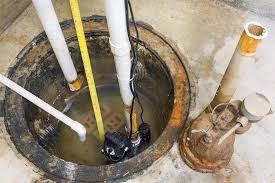Test the sump pump:
Test your pump every year before the “wet season” in early spring to ensure it’s ready when you need it most. To test, pour a bucket of water slowly into the sump pit. If the pump doesn’t activate once the water reaches a certain level, or if it doesn’t discharge the water properly, the pump may be clogged or malfunctioning. In this case, consult a licensed plumber for assistance.
Clean the pump: Start by unplugging the pump.
If the pump has a lid, remove it and use a flashlight to inspect the inside. Clear out any dirt, sand, gravel, or other debris that may have accumulated in the opening. Blockages in the incoming drainage lines can prevent water from entering the sump pit properly.
Check for worn parts:
Over time, a sump pump’s moving parts can wear out, affecting its performance. The float switch is a common culprit, and many manufacturers suggest replacing it every two years. Also, look for signs of corrosion and clean the inlet screen at the base of the pump.
Install a battery backup:
A battery backup ensures your sump pump continues to operate during a power outage. If you have one installed, test the battery by unplugging the pump to make sure it’s working properly.
Inspect the water discharge area:
Check that the discharge line is directing water at least 20 feet away from your house. Ensure the water is flowing freely and not getting blocked along the discharge path.
Signs your sump pump needs repair or replacement:
Your sump pump will show certain signs when it’s time for repairs or replacement. Reach out to a professional if you notice:
- Aging: Pumps typically last 7-10 years with average use. If yours runs frequently, it may only last 5-7 years
- Odors: A musty or moldy smell in your basement could indicate a malfunctioning sump pump
- Rust: Older pumps made from non-rust-resistant materials may show signs of rust. If the rust can’t be removed, it’s time for a replacement or repair
- Noises: Unusual sounds, such as humming, clanging, or banging, are signs the pump may need to be replaced
- Water: If you notice water in your basement, it means the sump pump isn’t doing its job and needs attention.
Protect your home:
Even with regular maintenance, your sump pump could still fail, potentially leading to costly damage. Standard home insurance policies may not cover pump failures, so it’s worth considering water backup coverage on your insurance policy to protect your property in the event of a sump pump malfunction.


